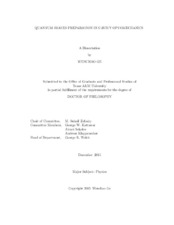| dc.description.abstract | Quantum entanglement and quantum superposition are fundamental properties of quantum mechanics, which underline quantum information and quantum computation. Preparing quantum states in the macroscopic level is both conceptually interesting for extending quantum physics to a broader sense and fundamentally important for testing the validity of quantum mechanics. In this dissertation, schemes of preparing macroscopic entanglement and macroscopic superposition states in cavity optomechanics are studied using the unitary evolution method in the nonlinear regime or Lyapunov equation in the linearized regime. Quantum entanglement and quantum superposition states can be realized using experimentally feasible parameters with the proposals in this dissertation.
Firstly, a scheme of entangling two movable end mirrors in a Fabry-Perot cavity that are coupled to a common single photon superposition state is studied. It is shown that strong entanglement can be obtained either in the single-photon strong coupling regime deterministically or in the single-photon weak coupling regime conditionally.
Secondly, a scheme of entangling two movable end mirrors, that are coupled to two-mode entangled fields generated from a correlated-emission laser is investigated. By tuning the input driving laser frequencies at the Stokes sidebands of the cavity, the radiation-pressure coupling can be linearized as an effective beam-splitter-like interaction. Hence entanglement can be transferred from the two-mode fields to the two mechanical mirrors. Macroscopic entanglement between macroscopic mirrors persists at temperature ~ 1K.
Thirdly, a scheme of creating macroscopic quantum superpositions of a mechanical mirror via periodically flipping a photonic qubit is proposed. Quantum superposition states of a mechanical mirror can be obtained via the nonlinear radiation coupling with a single-photon superposition state. However, the difference between two superposed mechanical states is very small due to the weak single-photon coupling rate available in experiment. By periodically flipping the photonic qubit state, the difference can be magnified. It is shown in detail that this scheme is experimentally feasible under current technology. | en |


